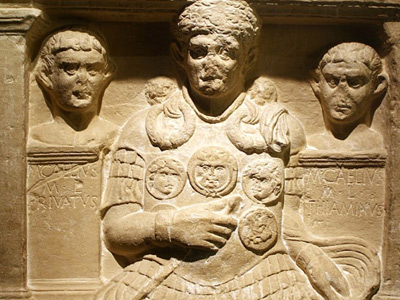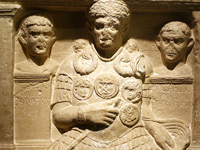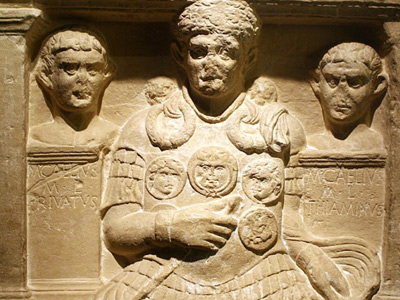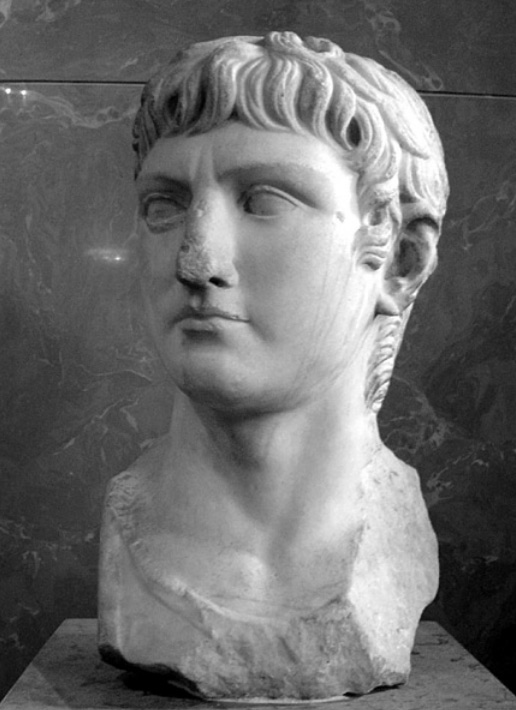Battle of the Teutoburg Forest (9 AD)

Background
In 4 CE the Roman general (and later emperor) Tiberius entered Germania and subjugated the Cananefates in Germania Inferior, the Chatti near the upper Weser River and the Bructeri south of the Teutoburg Forest. After these conquests he led his army across the Weser.
In early 6 CE Legatus Gaius Sentius Saturninus and Consul Legatus Marcus Aemilius Lepidus led a massive army of 65,000 heavy infantry legionaries, 10,000–20,000 cavalrymen, archers, 10,000–20,000 civilians (13 legions and their entourage, totalling around 100,000 men) in an offensive operation against Maroboduus, the king of the Marcomanni, who were a tribe of the Suebi. Following their defeat at the hands of Drusus I in 9 BCE the Marcomanni had fled into the territory of the Boii, from which they formed an alliance with the Hermunduri, Quadi, Semnones, Lugians, Zumi, Butones, Mugilones, Sibini and Langobards. Later in 6 CE, leadership of the Roman force was turned over to Publius Quinctilius Varus, a nobleman and experienced administrative official from a patrician family who was related to the Imperial family. He was assigned to consolidate the new province of Germania in the autumn of that year.
Tiberius was then forced to turn his attention to the Bellum Batonianum, also known as the Great Illyrian Revolt, which broke out in the province of Illyricum. Led by Bato the Daesitiate, Bato the Breucian, Pinnes of Pannonia, and elements of the Marcomanni, it lasted nearly four years. Tiberius was forced to stop his campaign against Maroboduus and recognise him as king so that he could then send his eight legions (VIII Augustan, XV Apollonian, XX Victorious Valerian, XXI Predator, XIII Twin, XIV Twin, XVI Gallic and an unknown unit) to crush the rebellion in the Balkans.
Nearly half of all Roman legions in existence were sent to the Balkans to end the revolt, which was itself triggered by constant neglect, endemic food shortages, high taxes, and harsh behavior on the part of the Roman tax collectors. This campaign, led by Tiberius and Quaestor Legatus Germanicus under Emperor Augustus, was one of the most difficult, and most crucial, in the history of the Roman Empire The Roman Empire was the post-Republican period of ancient Rome. As a polity, it included large territorial holdings around the Mediterranean Sea in Europe, North Africa, and Western Asia, and was ruled by emperors. The first two centuries of the Roman Empire saw a period of unprecedented stability and prosperity known as the Pax Romana ('Roman Peace'). The Empire was later ruled by multiple emperors who shared control over the Western Roman Empire and the Eastern Roman Empire.. Due to this massive redeployment of available legions, when Varus was named Legatus Augusti pro praetore in Germania, only three legions were available to him.
The Roman Empire was the post-Republican period of ancient Rome. As a polity, it included large territorial holdings around the Mediterranean Sea in Europe, North Africa, and Western Asia, and was ruled by emperors. The first two centuries of the Roman Empire saw a period of unprecedented stability and prosperity known as the Pax Romana ('Roman Peace'). The Empire was later ruled by multiple emperors who shared control over the Western Roman Empire and the Eastern Roman Empire.. Due to this massive redeployment of available legions, when Varus was named Legatus Augusti pro praetore in Germania, only three legions were available to him.
Varus' name and deeds were well known beyond the empire because of his ruthlessness and crucifixion of insurgents. While he was feared by the people, he was highly respected by the Roman senate. On the Rhine, he was in command of the XVII, XVIII, and XIX legions. These had previously been led by General Gaius Sentius Saturninus, who had been sent back to Rome after being awarded an ornamenta triumphalia. The other two legions in the winter-quarters of the army at castrum Moguntiacum were led by Varus' nephew, Lucius Nonius Asprenas and perhaps Lucius Arruntius.
Following the attacks of Drusus I in 11–9 BCE, Varus' opponent, Arminius, along with his brother Flavus, had been sent to Rome as tribute by their father, Segimerus the Conqueror, chieftain of the noblest house in the tribe of the Cherusci. Arminius then spent his youth in Rome as a hostage, where he had received a military education, and even been given the rank of Equestrian. During Arminius' absence, Segimerus was declared a coward by the other Germanic chieftains, because he had submitted to Roman rule, a crime punishable by death under Germanic law. Between 11 BCE and 4 CE, the hostility and suspicion between the Germanic tribes deepened. Trade and political accords between the warlords deteriorated. Tacitus wrote that the Chatti were hostile, and subjugated the Cherusci, but were themselves "pacified" between 4 and 6 CE. Velleius Paterculus also reports that in the years 1–4 CE, there was unrest in Germania.
After his return from Rome, Arminius became a trusted advisor to Varus, but in secret he forged an alliance of Germanic tribes that had traditionally been enemies. These included the Cherusci, Marsi, Chatti, Bructeri, Chauci, Sicambri, and remaining elements of the Suebi, who had been defeated by Caesar in the Battle of Vosges. These five were some of the fifty Germanic tribes at the time. Using the collective outrage over Varus' tyrannous insolence and wanton cruelty to the conquered, Arminius was able to unite the disorganized tribes who had submitted in sullen hatred to the Roman dominion, and maintain said alliance until the most opportune moment to strike.
Between 6 and 9 CE, the Romans were forced to move eight of eleven legions present in Germania east of the Rhine river to crush a rebellion in the Balkans, leaving Varus with only three legions to face the Germans. This represented the perfect opportunity for Arminius to defeat Varus.
While Varus was on his way from his summer camp west of the Weser river to winter headquarters near the Rhine, he heard reports of a local rebellion, reports which had been fabricated by Arminius. Edward Shepherd Creasy writes that "This was represented to Varus as an occasion which required his prompt attendance at the spot; but he was kept in studied ignorance of its being part of a concerted national rising; and he still looked on Arminius as his submissive vassal ...".
Varus decided to quell this uprising immediately, expediting his response by taking a detour through territory that was unfamiliar to the Romans. Arminius, who accompanied him, directed him along a route that would facilitate an ambush. Another Cheruscan nobleman, Segestes, brother of Segimerus and unwilling father-in-law to Arminius, warned Varus the night before the Roman forces departed, allegedly suggesting that Varus should apprehend Arminius, along with other Germanic leaders whom he identified as participants in the planned uprising. His warning, however, was dismissed as stemming from the personal feud between Segestes and Arminius. Arminius then left under the pretext of drumming up Germanic forces to support the Roman campaign. Once free from prying eyes, he immediately led his troops in a series of attacks on the surrounding Roman garrisons.
Recent archaeological finds place the battle at Kalkriese Hill in Osnabrück county, Lower Saxony. On the basis of Roman accounts, the Romans were marching northwest from what is now the city of Detmold, passing east of Osnabrück after camping in the area, prior to the attack.
HISTORY

RESOURCES
This article uses material from the Wikipedia article "Battle of the Teutoburg Forest (9 AD)", which is released under the Creative Commons Attribution-Share-Alike License 3.0.
© Stories Preschool. All Rights Reserved.










